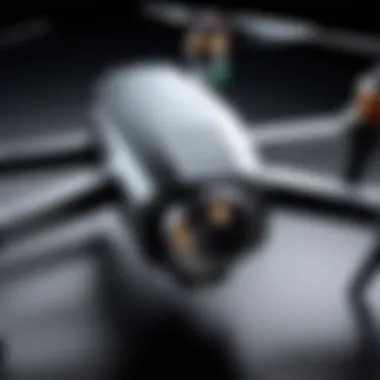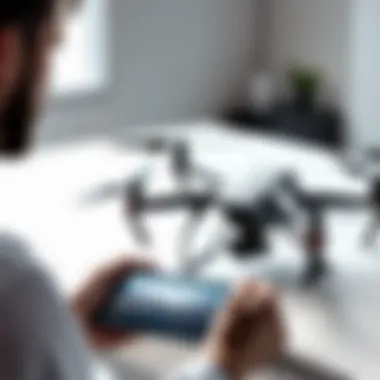Best Drones Under $1000: Top Picks and Reviews


Intro
The rise of drones has transformed various industries, from photography to agriculture. For tech enthusiasts and IT professionals, finding the right drone is crucial, especially when budget constraints come into play. This article focuses on drones available for under $1,000. An informed choice in this price range can lead to a balance of quality and innovation without overspending.
Understanding the essential features of each drone model is key. The discussion will cover camera specs, flight time, and unique selling points that differentiate models within this price bracket. Furthermore, real-world performance assessments will reveal how well these drones function in diverse conditions, providing a clear picture for potential buyers. Readers will gain insights to navigate this crowded market effectively.
Features Overview
When choosing a drone, it is vital to familiarize yourself with multiple features that impact functionality and user satisfaction.
Key Specifications
- Camera Quality: Look for models equipped with at least 4K video capabilities, ensuring rich and detailed imagery.
- Flight Time: Many drones offer flight times between 20 to 30 minutes. Consider battery life, especially for extended outdoor use.
- Range: A good range is typically around 3 to 7 kilometers. This allows for expansive exploration without losing connection.
- User Interface: Models should have intuitive controls, ideally with beginner-friendly modes for novices.
Unique Selling Points
Drones each have distinct features that set them apart:
- DJI Mini SE: Compact design with a 3-axis gimbal makes it perfect for travel.
- Autel Robotics EVO Lite: Known for superior low-light performance due to its larger sensor.
- Holy Stone HS720E: Offers GPS-assisted flight and advanced features at an attractive price.
Performance Analysis
Evaluating performance involves more than just statistics. Actual use cases play a significant role in understanding how drones perform under various conditions.
Benchmarking Results
Various benchmarks have been conducted to assess drone functionalities:
- Speed Tests: Many models can achieve speeds up to 15 m/s. This is important for capturing quick movements.
- Stability Tests: Assessing how well drones respond to wind can help determine reliability, especially for outdoor shoots.
- Camera Performance: Image stabilization tends to vary; hence, testing still versus moving objects is essential.
Real-world Scenarios
In practical applications, the following scenarios demonstrate how these drones hold up:
- Aerial Photography: While flying over landscapes, models like DJI Mini SE excel at capturing stunning images.
- Inspection Tasks: Drones like Autel Robotics EVO Lite are proving useful in surveying buildings due to their clarity in low-light conditions.
Foreword
The significance of selecting the right drone under $1,000 cannot be understated. As the popularity of drone technology grows, understanding the varied options available is essential for both IT professionals and tech enthusiasts. These individuals often require precise evaluations to facilitate informed purchasing decisions. This article aims to dissect the offerings within this price range, focusing on vital features and performance metrics that define a drone's value. By delving into the specifications and intended uses of several models, we strive to equip readers with knowledge to navigate the market effectively.
Overview of Drones
Drones have rapidly evolved from luxury gadgets to versatile tools used in various industries. They now serve purposes ranging from aerial photography to reconnaissance and mapping applications. The accessibility of drones has democratized their use, allowing many different users to harness their potential. A substantial number of models available under $1,000 present excellent capabilities that meet the needs of both casual and serious users. Knowing how to assess these capabilities will underline the purchasing decision.
Importance of Budget Considerations
Operating within a specific budget often dictates the capabilities and features available to a buyer. Staying under $1,000 enables many users to access high-quality drones that perform admirably while avoiding overspending. This budget consideration is vital, as it not only influences what features are prioritized but also impacts the overall user experience. Balancing quality with cost ensures that users receive optimal performance without the financial strain.
Many of the top drones within this price point include advanced features like high-resolution cameras, impressive flight times, and stable connectivity. By recognizing the key elements of budget constraints, buyers can make calculated choices that align with their needs and expectations.
Key Features to Consider
When selecting a drone, particularly those priced under $1,000, certain features significantly influence performance and usability. Understanding these key features can aid tech enthusiasts and information technology professionals in choosing the right model. A careful assessment can lead to informed decisions that align with specific needs and preferences. Key elements like camera quality, flight time, control range, and build quality will be detailed to provide clarity into their impact on overall drone experience.
Camera Quality and Capabilities
Resolution


Resolution is one of the most critical aspects when evaluating a drone's camera. A higher resolution generally leads to clearer and more detailed images. For users interested in aerial photography or videography, a resolution of 4K or higher is typically desirable. This high resolution captures more information, allowing for more significant post-processing options without losing quality. However, it is essential to consider the file size, as higher resolution can lead to larger storage requirements.
Stabilization Technology
Stabilization Technology is crucial for capturing smooth video footage, especially during movement or windy conditions. Drones equipped with advanced stabilization systems like gimbals provide steady images, reducing shake. Effective stabilization enhances the overall quality of video, making it more professional looking. This feature is particularly useful for professionals looking to produce high-quality content, although it may add to the drone's cost.
Field of View
Field of View (FOV) refers to the extent of the observable environment captured by the camera. A wider FOV allows for more expansive shots, which can be beneficial for landscape photography or capturing events. The typical FOV ranges from 70 to 120 degrees. While a broader view is advantageous, users should be aware that it can sometimes lead to distortion in images at the edges. Choosing an appropriate field of view depends on the intended use of the drone's camera.
Flight Time and Battery Life
Typical Flight Duration
Typical Flight Duration indicates how long a drone can operate on a single battery charge. Most drones under $1,000 offer flight times between 20 to 30 minutes. Prolonged flight times enhance the user experience by reducing downtime spent on recharging or swapping batteries. However, it is crucial to balance between flight duration and other features, as higher-performing drones may have shorter flight times.
Battery Charging Time
Battery Charging Time is also an essential factor. Quick charging capabilities can be a significant benefit for users needing to maximize their flying time. Typically, batteries can take from 30 minutes up to two hours to recharge. Fast charging options can improve overall accessibility but may come at a higher price point. Understanding the charging time aids in planning for extended drone sessions.
Control Range and Connectivity
Effective Range
Effective Range refers to how far the drone can operate from the controller while maintaining a stable connection. Typically, drones in this price range have effective ranges from several hundred meters to a few kilometers. A greater range allows for more exploratory flights, though it often depends on local regulations and the drone's design. This element is vital for users planning to fly in vast open areas.
Signal Types
Signal Types such as radio frequency (RF) or Wi-Fi significantly affect connectivity. RF signals tend to offer better range and stability, particularly in rural areas. Wi-Fi can be simpler but may be limited by obstacles and congested frequencies. A solid signal type ensures that users maintain better control over the drone, ultimately enhancing the flying experience.
Build Quality and Durability
Material Composition
Material Composition impacts a drone’s overall durability and performance. Drones made from high-quality materials like carbon fiber or robust plastics can withstand impacts and rough conditions. While these types of materials may increase the cost, they also provide longer-lasting performance.
Resistance to Weather
Resistance to Weather is vital if planning to fly in various conditions. Drones with weather-resistant features can operate in light rain or strong winds more effectively than their counterparts. This functionality extends the usability and longevity of the drone but may not always be available within the budget of $1,000. By focusing on these key features, buyers can make informed decisions that best fit their needs and usage expectations.
Top Drones Under
Drones have evolved significantly in recent years, making them accessible to a wider audience. This section focuses on top drones under $1,000 that offer advanced features and impressive performance. With the growing popularity of drone usage in various fields such as photography, mapping, and recreation, understanding your options is crucial.
Investing in a drone under $1,000 provides excellent value for tech enthusiasts and professionals alike. These models often feature high-quality cameras, long flight times, and user-friendly controls, making them ideal for casual users and serious hobbyists. When evaluating these drones, it is essential to consider specifications closely.
Some key factors include camera capabilities, battery life, overall build quality, and flight range. This ensures that you find a drone that meets your requirements without exceeding your budget.
DJI Mini
Specifications
The DJI Mini 2 is renowned for its compact design and capabilities. It boasts a 12 MP camera that can shoot 4K video at 30 frames per second. This high-resolution quality is ideal for users seeking stunning aerial footage.
Another significant feature of the DJI Mini 2 is its weight. At just 249 grams, it falls under the weight limit that requires FAA registration in the United States. This characteristic enhances its appeal for leisure and travel. Users appreciate the 31-minute flight time, which is competitive within its category.
"This drone is lightweight and powerful, making it a top choice for beginners and seasoned pilots."
Use Cases


The Mini 2 excels in various scenarios. Hobbyists enjoy using it for capturing breathtaking landscapes during vacations. Its small size and ease of transport allow for quick deployment whenever inspiration strikes. Moreover, professional videographers can utilize the Mini 2 for filming events, given its reliable performance and camera features.
Its ease of use makes it attractive to novices as well. The intuitive controls allow even those who never flown a drone to get up in the air quickly.
Pros and Cons
The DJI Mini 2 displays several strengths. Battery life is impressive, and its camera quality is superior to many competitors. The small size allows for easy transport.
However, it does have some weaknesses. The lack of obstacle avoidance sensors can be a potential drawback for inexperienced users. Additionally, the limited zoom capability may not satisfy users who require higher-end features.
Autel Robotics EVO Lite
Specifications
The Autel Robotics EVO Lite offers a 50 MP camera capable of shooting 6K video. This drone's camera quality stands out, surpassing many competitors within this price range.
Additionally, it provides an impressive flight time of about 40 minutes. This allows users to capture extensive footage without frequently returning to recharge.
Use Cases
Users often favor the EVO Lite for professional applications. Photographers and filmmakers can leverage its superior camera to create high-quality content. The drone also proves beneficial in surveying tasks, where detailed imaging is essential.
Hobbyists also enjoy this model for long-range photo outings, given its robust signal range.
Pros and Cons
The key advantages of the EVO Lite include its camera quality and extended flight time. These aspects make it a desirable option for those requiring high performance.
However, the price can be a con. It may be slightly above the budget for some buyers. Its bulkier design compared to ultralight drones may deter users who seek portability.
Parrot Anafi USA
Specifications
The Parrot Anafi USA offers a unique blend of features. It includes a 32 MP camera capable of 4K HDR video. What sets it apart is its ability to capture thermal images, making it suitable for specialized tasks such as inspections and search and rescue missions.
With a 32-minute flight time, it performs competitively with other drones recognized for extended use.
Use Cases
The Anafi USA is often chosen for professional and industrial applications. Inspectors can evaluate roofs or solar panels, using the thermal imaging to identify issues effectively.
Casual users may find it less attractive due to its specific targeting, but those in sectors such as emergency services may find it invaluable.
Pros and Cons
Advantages include the unique thermal imaging and high-resolution camera. These features cater to a market looking for specialized capabilities.
On the downside, its niche applications may limit the target audience. Additionally, the somewhat complicated controls can be a challenge for beginners.
Holy Stone HS720
Specifications
Holy Stone HS720 features a 12 MP camera with 4K recording capabilities, making it a solid choice within this price segment. Its controllable video stabilization also enhances recorded footage quality, allowing for smooth results without heavy post-processing.
This drone also boasts GPS functionality. Users find this beneficial for precise tracking and returning home features.
Use Cases


The HS720 is great for casual users who want quality at an affordable price. Families may enjoy capturing moments during outings and vacations. Its easy-to-use controls make it suitable for young users too.
Professionals can use it, but might prefer other models due to the camera quality limitations in some scenarios.
Pros and Cons
The pros include affordability and ease of use, making it attractive for entry-level users. It also offers dependable flight stability.
However, there are cons. The camera may not meet the needs of seasoned professionals seeking advanced imaging capabilities. Battery life is decent but not as competitive as others in this price bracket.
Understanding these top drones under $1,000 will help you make an informed choice. Assess your needs and preferences carefully to select the right model.
Comparative Analysis
In this section, we focus on the comparative analysis of the drones that were presented earlier. This analysis serves a crucial role in determining the most suitable options for individuals looking to invest under a $1,000 budget. By highlighting important performance metrics and user experience factors, potential buyers can make informed decisions that best align with their needs and expectations.
Performance Metrics
Speed and Agility
Speed and agility in drones are vital for capturing high-quality footage and ensuring safe operations. Drones that exhibit superior speed can cover more ground quickly, making them desirable for aerial photography enthusiasts. The key characteristic of speed is its direct influence on the overall responsiveness of the drone. Faster drones can maneuver easily in dynamic environments, which is often necessary during events or activities where the subject is moving.
One unique feature is the ability to switch between flight modes. Many drones offer specialized modes, such as sport mode, which maximizes speed, making these models a popular choice for thrill-seekers. However, the downside might be a steeper learning curve for beginners, as higher speeds can lead to more challenging control.
Stability in Flight
Stability in flight is paramount when considering a drone's performance. A stable drone ensures smooth footage, which is critical for those engaged in video production or photography. The key characteristic of stability is its reliance on advanced stabilization technologies like gimbals and GPS. Drones that boast these features provide consistency in flight, allowing operators to capture steady, professional-grade videos.
A unique feature that promotes stability is the multiple-axis gimbal systems, which help to negate unwanted camera movement. This characteristic is beneficial for maintaining quality footage. However, one disadvantage might be the increased cost associated with these advanced systems, which could limit options for those on a tighter budget.
User Experience
Ease of Use
Ease of use is a fundamental aspect that influences user satisfaction and engagement. Drones that are user-friendly often have intuitive controls and straightforward setup procedures, making them accessible for both beginners and seasoned professionals. A critical aspect of ease of use is the quality of the remote control system. Ergonomic controllers with responsive controls facilitate a more enjoyable flying experience.
A unique aspect of ease of use lies in the incorporation of automated flight modes, which can include features such as auto take-off and landing. While this can be advantageous for novice pilots, users might find that relying too heavily on automation limits their learning potential over time.
Software and App Integration
Software and app integration are increasingly vital for enhancing the drone experience. Many modern drones come equipped with proprietary apps that facilitate flight planning and allow for seamless editing of captured content. The key characteristic of software integration is its ability to provide users with real-time data, including battery levels and GPS tracking.
A notable feature in this realm is live streaming capabilities directly from the drone to mobile devices, which adds a layer of convenience for users. However, a potential drawback could be the need for constant software updates, which may pose compatibility issues with older devices.
The ability to compare drones based on these performance metrics and user experiences ultimately leads to a more informed and satisfying purchase decision for potential buyers.
In summary, comparative analysis serves as a tool to dissect important factors related to drone performance and user friendliness. Understanding speed, agility, stability, ease of use, and software integration prepares potential buyers to select a drone that fits their specific needs and preferences.
The End
In this article, the conclusion serves as a crucial part in synthesizing the various discussions surrounding drones under $1,000. It not only summarizes the significant findings but also emphasizes the relevance of understanding these devices in a rapidly evolving market. This section elucidates on the important aspects that IT professionals and tech enthusiasts should consider when selecting a drone.
Final Recommendations
To make an informed choice, it is important to weigh the options among the top drones evaluated in this article. Here are some recommended drones based on specific user needs:
- DJI Mini 2: Ideal for those who prioritize portability and simplicity, offering high-quality image capture and ease of use.
- Autel Robotics EVO Lite: Best suited for users looking for enhanced camera features and longer flight times, making it suitable for aerial photography enthusiasts.
- Parrot Anafi USA: A strong choice for professionals in need of advanced imaging technology and robustness in challenging environments.
- Holy Stone HS720: A great entry-level option for beginners, providing essential functions at a competitive price.
Future Trends in Drone Technology
Drones are entering a new phase of technological advancement. Future trends are shaping the capabilities of these devices, incorporating:
- Artificial Intelligence: Drones will increasingly utilize AI for better navigation and object recognition, enhancing automation and user experience.
- Increased Battery Efficiency: Innovations in battery technology are expected, leading to longer flight times and reduced charging times.
- Enhanced Connectivity: 5G and improved signal technology will enable more robust connections, allowing for real-time streaming and data transfer.
- Regulatory Developments: As drone use becomes more widespread, regulatory frameworks will evolve, influencing how drones can be used commercially and recreationally.
Understanding these trends will aid potential buyers in making choices that not only fulfill current needs but also align with future developments in drone technology.



